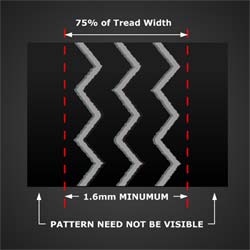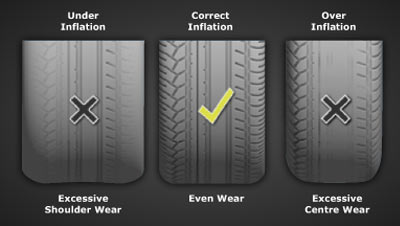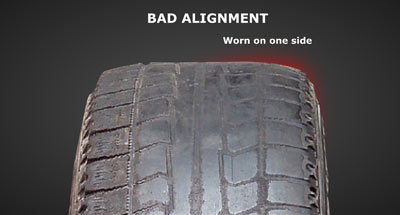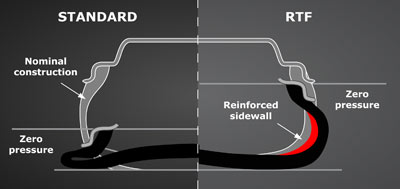Tyre Law
Tyres must be suitable (i.e. of the correct type and size) for the use to which the vehicle is being put and must be inflated to the vehicle or tyre manufacturers’ recommended pressures.
Tyres of different types must not be fitted on the same axle, i.e. cross ply / radial or directional / asymmetric. On a two axle vehicle with single rear wheels, radial tyres must not be fitted to the front if cross ply tyres are fitted to the rear.
No tyre must have a break in its fabric or a cut deep enough to reach the body cords. No cut must be more than 25mm or 10% of the tyres section width in length, whichever the greater.
There must be no lump, bulge or tear caused by separation or partial fracture of its structure, neither must any portion of the ply or cord structure be exposed.
Tyre Size – What it means
235/45 ZR 17 94W
235 = nominal section width of the tyre in millimetres.
45 = the aspect ratio of the tyre; this means the height of the tyres cross section
expressed as a percentage of its width
Z =speed category indicating that the tyre is suitable for speeds over 240 kph.
R = radial construction
17 =nominal diameter of the rim to which the tyre should be fitted (in inches)
94 = load index indicating that the tyre can support a load of 670 kg
W = speed category indicating that the tyre is suitable for speeds up to 168 mph.
Tread Depth
A new car tyre begins life with approximately 8 mm of tread, the minimum legal tread depth is 1.6 mm, most motoring organisations recommend changing at 2 mm while the majority of manufacturers recommend changing at 3 mm.
As the tread depth reduces, the tyres ability to remove water from the road surface also reduces, increasing the risk of aquaplaning and because the tyre is unable to transmit traction and braking forces to the road as effectively the vehicles stopping distances increase.
Tread depth new 8mm. 7mm 16% worn. 6mm 31% worn. 5mm 47% worn 4mm 63% worn. 3mm 78% worn. 2mm 94% worn. 1.6mm 100% worn.

STOPPING DISTANCE BRAKING FROM 50 mph ON A WET ROAD
Although the legal minimum tread depth is only 1.6 mm, research shows that Tyres with 3 mm of tread have an average 25% better performance than those at 1.6 mm— which represents an extra 8 metres stopping distance in wet conditions.
Reasons for Replacing Tyres
Normal wear and tear. There is no set pattern, it can be down to type of driving, location etc. On a front wheel drive car the front tyres will usually wear more quickly due to the increased work load on the front axle.
Premature wear. Can be caused by incorrect tyre pressures, incorrect wheel alignment or overloading of the vehicle.
Damage. This can be due to the tyre hitting the kerb or a pot hole in the road.
Incorrect tyre pressures can also affect the fuel consumption by as much as 10% and will also affect the road holding characteristics of the car.
Reasons for premature wear
Over inflation; Tyres will wear more in the centre of the tread.
Under inflation; Tyres will wear more on both tyre edges.
In both of the above situations efficiency and traction would also be lost due to the reduced area of tread in contact with the road. Over an extended period this will also result in increased fuel consumption.

Tracking; Incorrect wheel alignment can result in rapid wearing on the edges of the tyre and could affect the handling of the vehicle.

Valves
Play an important part in maintaining the correct pressure within the tyre.
A valve cap in good condition is essential to provide a primary seal and prevent dirt getting in.
As a result of centrifugal force the valve body is subjected to a force equivalent to 1.7 kg.
The valve should be changed every time a new tyre is fitted, or if the tyre is removed for repair or examination.
Speed Index
Speed Symbol Max speed for which tyre is suitable
| Symbol | MPH |
| S | 113 |
| T | 116 |
| H | 130 |
| V | 150 |
| W | Up to 168 |
| Z | Up to 150 |
| Y | Up to 186 |
The Benefits of Fitting Premium Tyres
Budget tyres are usually made from different compounds to premium tyres, these are often harder and make the tyres noisier on the road and wear more quickly.
Premium tyres are more technically advanced, with tread patterns designed to disperse water at higher rates from under the tyre giving better road holding and more grip under acceleration and braking.
Many premium tyres are designed specifically for certain car models and are an intrinsic part of that vehicles suspension, fitting budget tyres may alter the way the car behaves when cornering or braking, or in poor weather conditions.
Run Flat Tyres
What are Run Flat tyres?
Run Flat tyres are those specially designed to maintain the car’s mobility if the tyre has a puncture. This is mainly achieved by the tyres having much thicker sidewalls which will continue to hold the weight of the car even when the air pressure inside drops. This is designed as a safety feature as it allows the driver to continue driving until it is safer and more convenient to stop and get the tyre repaired.
The pressure is monitored in a variety of ways depending upon the vehicle manufacturer. Many systems have the sensor on the valve inside the tyre so any damage to this will necessitate a replacement valve, sometimes at considerable cost.

When a tyre is punctured, or the pressure drops below a predetermined level, the driver is alerted by a tyre pressure monitoring system in the car. The vehicle handbook will give precise guidance but generally the car should not be driven above 50mph or for more than 50 to 100 miles before the tyre must be repaired or replaced. The further it is driven, the less likely it is to be repaired as the increased weight on the tyre sides could damage it inside.
Can you fit normal tyres to a car set up for Run Flat tyres?
No, you should not put non-Run Flat tyres on a car set up for Run Flat tyres! There are two main reasons for this.
- Because Run Flat tyres are very hard due to the reinforced sidewall, the suspension on the car is set much softer so the ride is normal for occupants. If a normal tyre is fitted then the ride will feel very soft, the handling will be adversely affected and could present serious safety concerns.
- As the car will not have a spare to deal with a flat tyre, if non-Run Flat tyres are fitted, the car will be stranded if a puncture does occur.
Can you fit Run Flat tyres to a car not initially set up for Run Flat tyres?
No you should not fit Run Flat tyres on a car not originally set up for it!
- The car will not have a tyre pressure monitoring system installed and consequently the driver will have no idea if a puncture occurs and will continue to drive normally with catastrophic ramifications.
- Run Flat tyres are much harder and therefore the ride will be much harsher and it will affect the handling and feel of the car.
Never forget your MOT!
Join our free MOT reminder service. Simply click ‘join’ below, add your details, and we’ll email you a reminder with enough time to book.
We will not use your details for any other purpose and you can unsubscribe at any time.
Join